Complete Guide to Snorkeling With Manta Rays
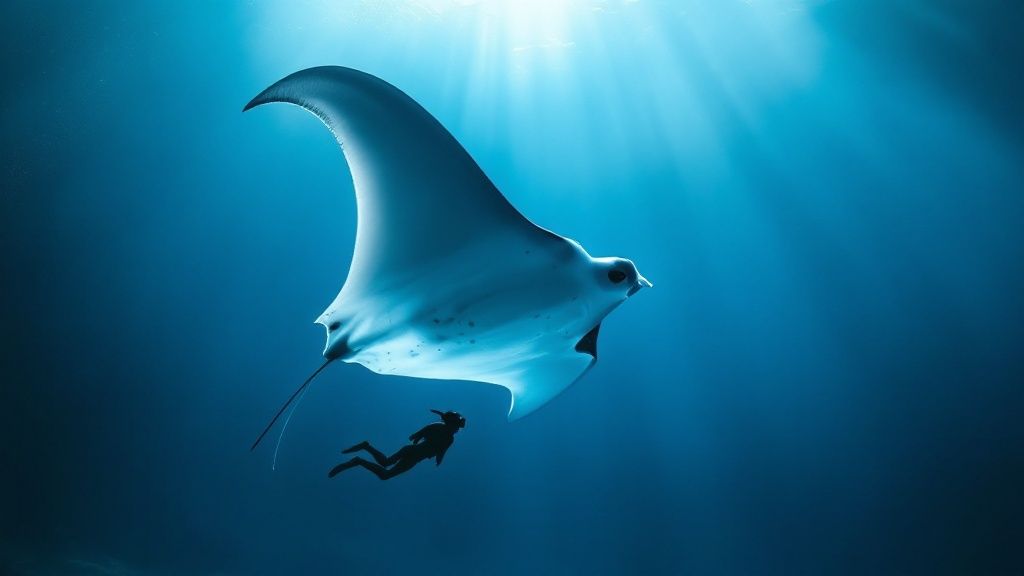
The Mesmerizing World of Manta Rays: Gentle Ocean Giants
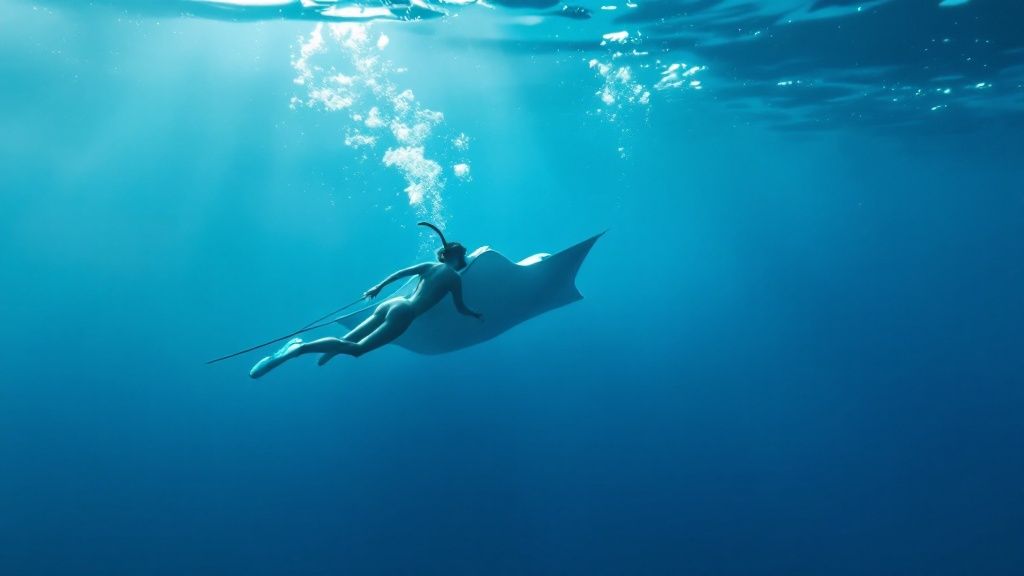
Manta rays, often called gentle ocean giants, hold a special fascination for snorkelers. Their graceful movements through the water create a captivating spectacle. With wingspans reaching up to 23 feet, their sheer size adds to their majestic presence, making a snorkeling encounter truly memorable.
Understanding Manta Ray Biology and Behavior
Manta rays are filter feeders, consuming large amounts of plankton and krill. This diet sets them apart from their stingray relatives, which have venomous barbs. Manta rays are harmless, allowing snorkelers to enjoy close-up encounters and observe their fascinating feeding habits without fear.
Manta rays also display complex social behaviors, a subject of ongoing research. Understanding these behaviors enriches the snorkeling experience. For example, recognizing individual manta ray personalities and movements can create a deeper connection with these intelligent animals.
Experienced guides, such as those at Kona Honu Divers, often identify individual mantas, personalizing the experience for snorkelers. This personalized approach enhances the impact of these encounters. Learning about manta ray biology also helps dispel any misconceptions, creating a more immersive experience.
Manta Ray Conservation and Global Populations
Manta rays face threats from fishing and habitat loss, making them vulnerable creatures. However, there are some thriving populations that offer a beacon of hope. Off the coast of Ecuador, a remarkable population of over 22,000 individuals represents the largest known oceanic manta ray population globally.
This thriving community highlights the importance of Ecuador and Isla de la Plata as key locations for manta ray conservation. You can find detailed statistics here. This healthy population supports a flourishing tourism industry centered around manta ray snorkeling and diving.
Protecting these populations is vital for preserving the economic advantages of manta ray tourism, like the tours offered by Manta Ray Night Snorkel Hawaii. The continued success of such tours depends on the health of manta ray populations. Companies such as Kona Snorkel Trips and Captain Cook Snorkeling Tours emphasize sustainable practices to help ensure the long-term survival of these magnificent animals. This underscores the need to choose responsible tour operators when planning your manta ray snorkeling adventure.
Prime Destinations for Unforgettable Manta Ray Encounters
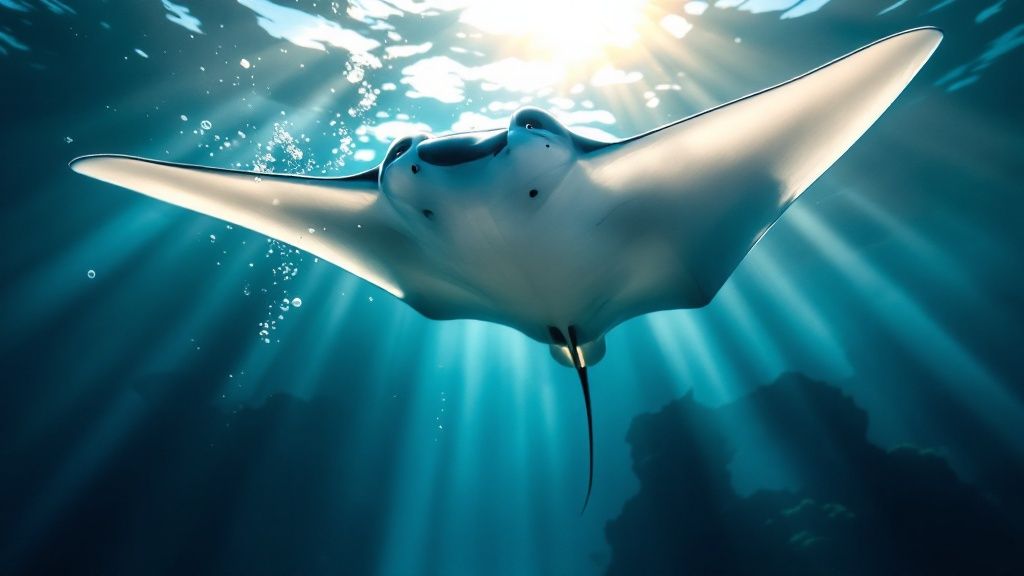
Snorkeling with manta rays is an incredible experience. Choosing the right location can make it even more memorable. This section explores some of the best places around the world to snorkel with these gentle giants. From the volcanic waters of Hawaii to the crystal-clear lagoons of the Maldives, there’s a perfect manta ray adventure waiting for you.
Kona, Hawaii: The Night Ballet of Manta Rays
Kona, Hawaii is famous for its nighttime manta ray snorkeling. Special lights attract plankton, the manta rays' main food source. As the plankton gather, the manta rays begin a captivating feeding display, gliding just below the surface.
This predictable feeding behavior makes Kona an excellent spot for reliable manta ray sightings. Manta Village and Manta Heaven are two popular locations. Manta Village is known for its calmer waters. Manta Heaven sometimes has larger groups of manta rays. Both offer amazing chances to see these majestic creatures up close. You can find more details on our sitemap for further details.
The Maldives: Year-Round Manta Encounters
The Maldives, a collection of stunning islands in the Indian Ocean, offers another fantastic opportunity to snorkel with manta rays. The warm, clear water supports a year-round manta ray population. Unlike locations with seasonal migrations, you’re likely to see these graceful creatures no matter when you visit.
Ari Atoll and Baa Atoll are especially well-known for their manta ray populations. These areas have abundant plankton, which attracts mantas and gives snorkelers incredible close encounters.
Ningaloo Reef, Australia: A Pristine Coral Paradise
Ningaloo Reef, off the coast of Western Australia, is a UNESCO World Heritage site known for its pristine coral and diverse marine life. It's also a major hotspot for manta rays, especially during the coral spawning season between March and June.
Snorkeling at Ningaloo Reef offers the chance to see manta rays feeding alongside other amazing animals like whale sharks and sea turtles. The clear, shallow water provides excellent visibility.
Other Global Hotspots
Besides these top three locations, several other destinations around the world offer rewarding manta ray snorkeling experiences.
To help you choose the perfect spot, we've put together a comparison table highlighting the key features of each destination.
To help you choose the best location for your manta ray snorkeling adventure, check out this comparison table:
Top Manta Ray Snorkeling Destinations Comparison: This table compares key aspects of the world's best manta ray snorkeling locations to help plan your perfect adventure.
| Destination | Best Season | Type of Experience | Visibility | Accessibility | Success Rate |
|---|---|---|---|---|---|
| Kona, Hawaii | Year-round | Night Snorkeling | Excellent | Easy | High |
| The Maldives | Year-round | Day Snorkeling | Excellent | Moderate | High |
| Ningaloo Reef | March – June | Day Snorkeling | Excellent | Moderate | High |
| Isla de la Plata | June – October | Day Snorkeling | Good | Moderate | Medium |
| Socorro Island | November – May | Day Snorkeling | Good | Difficult | Medium |
| Yap, Micronesia | Year-round | Day Snorkeling | Excellent | Moderate | Medium |
As you can see, each location offers a unique snorkeling experience with varying accessibility and success rates.
- Isla de la Plata, Ecuador: Known for its large oceanic manta rays.
- Socorro Island, Mexico: A remote location with impressive giant manta rays.
- Yap, Micronesia: Famous for its resident manta rays that visit cleaning stations.
Choosing the right destination depends on your travel style, budget, and the kind of experience you're looking for. Whether it’s a nighttime adventure in Kona or daytime exploration in the Maldives, snorkeling with manta rays promises an unforgettable experience.
Planning Your Dream Manta Ray Adventure: Essential Steps
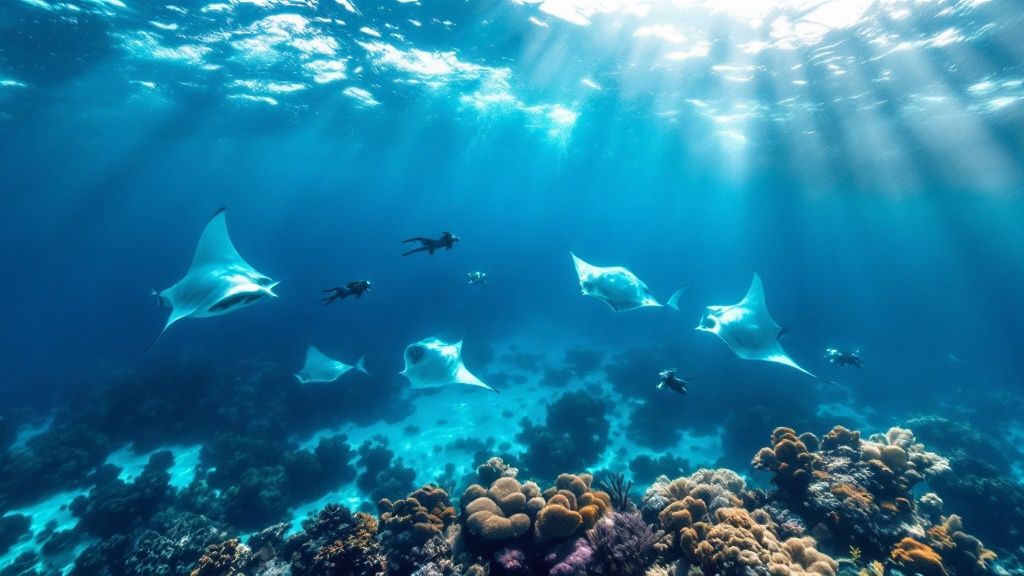
Turning your dream of snorkeling with manta rays into a reality starts with planning. This ensures an incredible experience and protects these majestic creatures. It involves everything from picking the right tour operator to understanding best practices for respectful underwater interactions.
Choosing a Responsible Tour Operator
Finding a reputable tour operator is crucial. Look for businesses committed to sustainable tourism and manta ray conservation. Ask about their group sizes, interaction guidelines, and conservation efforts. Inquire about certifications, permits, and compliance with local rules.
Choosing the right tour operator can make or break your trip. Smaller groups often offer more personalized interactions with the manta rays and guides. For further guidance, check out our guide on choosing the best tour operators.
Essential Equipment and Preparation
The right gear enhances your manta ray snorkeling adventure. Ensure your mask fits well and use anti-fog solution for clear underwater views. A wetsuit or rash guard provides comfort and protection, depending on the water temperature.
Preparing for the snorkeling conditions is also important. Research the water temperature and potential currents at your location. Physical preparation, such as swimming and snorkeling practice, builds confidence and stamina.
Timing, Group Size, and the Visitor Experience
Your tour's timing and group size significantly impact your manta ray encounter. Night snorkeling offers a special experience, as lights attract plankton, drawing manta rays closer to the surface. Smaller groups mean less crowding and a more intimate experience.
Unfortunately, even with careful planning, overcrowding can happen. A 2018 survey revealed that 82% of snorkelers felt crowded by other snorkelers, 78% by boats, and 69% by scuba divers during manta ray encounters. More detailed statistics are available here. This underscores the importance of selecting operators who prioritize sustainability and manage group sizes well.
Consider Kona Snorkel Trips and Captain Cook Snorkeling Tours for responsibly managed manta ray adventures. For snorkeling tips, see How to master snorkeling. By considering these factors, you contribute to a more sustainable and enjoyable experience for everyone.
Hawaii's Magical Night Manta Experience: A Complete Guide
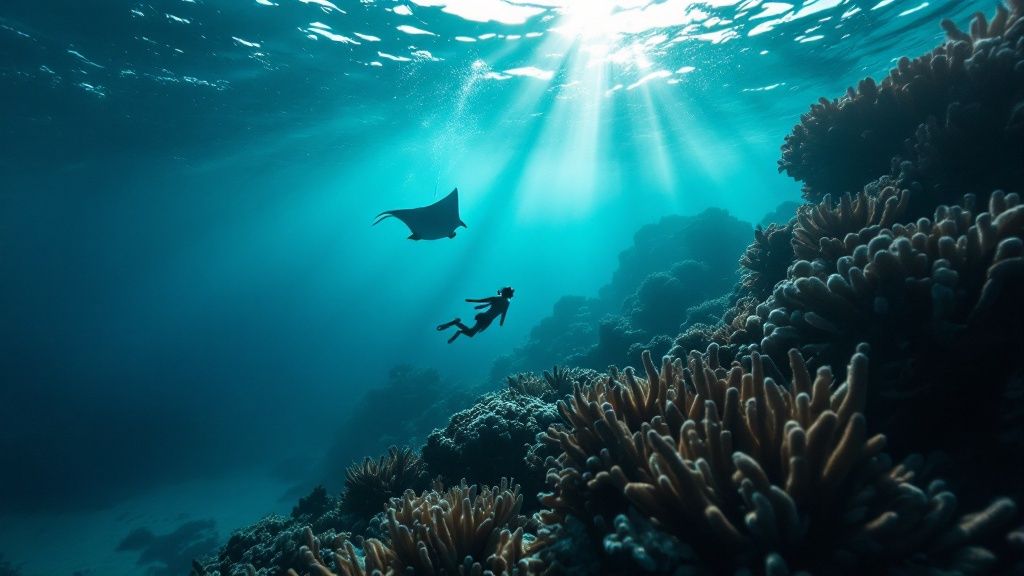
Snorkeling with manta rays in Kona, Hawaii, is an absolutely breathtaking experience. The Pacific Ocean's warm, clear waters provide a perfect backdrop for a nighttime adventure you won't soon forget. This guide will explore the details of this magical encounter, helping you understand what to expect and how to prepare for your own manta ray adventure.
The Science of the Spectacle: How Light Attracts Manta Rays
The magic of Kona's night snorkeling revolves around a simple yet fascinating biological principle: plankton are attracted to light. Plankton are the main food source for manta rays. Clever local tour operators use specialized lights to create a concentrated "plankton soup," which draws the manta rays closer to the surface.
This creates a mesmerizing display of feeding behavior just below the snorkelers, allowing for unbelievably close and memorable views of these graceful giants. This technique ensures an unparalleled opportunity to observe these majestic creatures in their natural habitat.
Kona's Manta Hotspots: Manta Village vs. Manta Heaven
Kona offers two primary locations for manta ray night snorkeling: Manta Village and Manta Heaven. Both spots boast high success rates for sightings, but each offers a unique experience. Manta Village, off the coast of Keauhou Bay, is known for its calmer waters, ideal for close-up encounters.
Manta Heaven, located near the airport, sometimes attracts larger groups of manta rays. Experienced guides from companies like Kona Snorkel Trips and Captain Cook Snorkeling Tours can offer valuable insights into the specific behaviors and sighting frequencies at both sites. Choosing the right guide can dramatically enhance your overall experience.
To help you choose the right tour, check out this comparison table:
Kona Manta Ray Tour Operators Comparison: Compare the features, prices, and highlights of top-rated manta ray snorkeling tour providers in Kona, Hawaii.
| Tour Company | Group Size | Duration | Price Range | Amenities | Special Features |
|---|---|---|---|---|---|
| Kona Snorkel Trips | 6-12 | 2 hours | $100-$150 | Snorkel gear, wetsuits, hot drinks | Underwater photography available |
| Captain Cook Snorkeling Tours | 10-20 | 2.5 hours | $120-$180 | Snorkel gear, flotation devices, snacks | Certified marine naturalist guide |
| Fair Wind Cruises | 40-60 | 3 hours | $150-$200 | Snorkel gear, dinner buffet, live music | Large boat with multiple viewing platforms |
| Sea Quest Hawaii | 6-12 | 2 hours | $90-$140 | Snorkel gear, wetsuits, hot chocolate | Small group experience |
This table provides a quick overview of some popular tour options, highlighting key differences in group size, duration, price, and added amenities. Choosing the right tour for your needs and budget can make a big difference in your experience.
From Boat to Ballet: Unpacking the Night Snorkeling Experience
A typical manta ray night snorkeling tour follows a structured format. The journey begins with a boat ride from the Kona coast, often departing near popular resorts. En route to the snorkeling site, the crew provides thorough pre-dive briefings, covering important safety guidelines and responsible interactions with the manta rays.
Once the boat is anchored, snorkelers enter the water and congregate around the illuminated light boards, attracting the plankton and, in turn, the manta rays. As these gentle giants glide through the water, feeding just below the surface, the experience transforms into a truly unforgettable spectacle. The guides' expertise and the well-organized tour ensure a safe and awe-inspiring adventure.
Preparing for an Emotional Underwater Encounter
Seeing manta rays up close is a profoundly moving experience. Many describe the encounter as life-changing, filled with a sense of awe and wonder. Videos like this extraordinary manta encounter offer a glimpse into the emotional impact of these graceful creatures.
Understanding what to expect, from the initial anticipation to the overwhelming feeling of connection, allows you to fully embrace the magic of the moment. Being prepared for this emotional experience enhances the overall wonder of snorkeling with manta rays. It's an adventure that will stay with you long after you leave the water.
Ethical Snorkeling: Protecting Mantas While Creating Memories
Snorkeling with manta rays is a truly awe-inspiring experience. There's nothing quite like sharing the water with these gentle giants. But it's vital to remember that manta rays are vulnerable creatures. Ethical snorkeling practices are key to protecting them while still creating unforgettable memories. This means respecting their space and choosing tour operators who prioritize conservation.
Choosing Responsible Tour Operators
Selecting the right tour operator is the first step towards ethical manta ray snorkeling. Look for operators who actively promote sustainable tourism practices. Ask about their group size limits, interaction guidelines, and what conservation initiatives they support. A committed operator will be happy to discuss these important details. For example, Kona Snorkel Trips emphasizes small group sizes for a more personalized and less intrusive experience. This allows for up-close observation without overwhelming the manta rays.
Furthermore, inquire about certifications and permits. These demonstrate a commitment to adhering to local regulations and following best practices for manta ray encounters. Responsible behaviors, such as proper boat anchoring techniques (away from known manta ray aggregation sites), and educating snorkelers on respectful interactions, signal genuine care for the animals and their well-being. Don’t hesitate to ask specific questions about how the operator is actively protecting the manta rays and their environment.
Respectful Interactions: Enhancing Your Experience and Protecting Mantas
Once in the water, maintaining a respectful distance is crucial. Avoid touching the manta rays. Touching them can disrupt their sensitive mucous layer, a vital component of their immune systems. This natural barrier provides protection from infections and parasites.
Touching can also transmit diseases from humans to the rays or disrupt their natural behaviors. This breathtaking footage shows how respectful encounters can lead to longer, more natural interactions with these gentle giants. It’s surprising how maintaining the proper distance actually increases the likelihood of a longer, more meaningful encounter.
Additionally, avoid sudden movements or chasing the manta rays. Allow them to approach you on their own terms. This patient approach creates a more natural and rewarding experience for everyone. Remember, these are wild animals, and our goal is to observe them in their natural habitat without causing any stress or disruption. For more information on responsible tourism, check out this sitemap.
The Economic Impact of Conservation: Protecting Mantas for Future Generations
Manta ray tourism holds significant economic value worldwide. It generates substantial revenue, estimated at $73 million annually in direct revenue and $140 million when including related tourism spending, according to a 2013 study. This income greatly overshadows the revenue from manta ray fisheries, which generated a mere $442,000 annually in Indonesia during the same period. To learn more about this disparity, read about the economic impact of manta rays.
This significant difference highlights the importance of prioritizing conservation for the long-term economic health of local communities that depend on manta ray tourism. By choosing ethical operators and engaging in responsible snorkeling practices, you directly contribute to the survival of manta ray populations globally. This ensures that future generations can also experience the magic of swimming alongside these magnificent creatures. Your choices matter and play a vital role in preserving these animals and their delicate ecosystems.
The Ultimate Manta Experience: What To Actually Expect
Beyond the captivating photos and videos, what's it really like to snorkel with manta rays? This section explores the authentic experience, from pre-dive anxieties to the sheer wonder of encountering these magnificent creatures. We'll cover the emotional journey and physical sensations, preparing you for the magic of this underwater ballet.
From Nervousness to Awe: The Emotional Rollercoaster
Picture yourself on a boat as the sun sets, about to enter the darkening ocean. A mix of excitement and nerves is perfectly normal. This feeling, common among first-time snorkelers, quickly shifts as the first manta ray gracefully emerges from the depths.
The sight of these gentle giants gliding through the water is often described as breathtaking. The initial anxiety melts away, replaced by a sense of awe and tranquility. This emotional transformation is a core element of the manta ray snorkeling experience.
Feeling the Ocean's Embrace: Physical Sensations
The physical sensations of snorkeling with manta rays add another layer to the encounter. You'll feel the gentle rhythm of the ocean currents and subtle temperature changes. The water displaced by the mantas' impressive size creates a gentle push, a tangible connection to their presence.
This can evoke a feeling of being part of something bigger, a deeper connection with the ocean. However, it’s wise to be prepared for the practical aspects. Some individuals might experience seasickness or discomfort from the snorkeling equipment.
Addressing these possibilities beforehand, like taking motion sickness medication or ensuring a proper mask fit, can significantly improve your comfort.
Managing Expectations: From Distant Views to Close Encounters
Each manta ray snorkeling experience is unique. Some encounters might involve distant observations, while others offer remarkably close interactions. The beauty lies in the unpredictability. Even with optimal lighting and expert guidance, like the tours provided by Kona Honu Divers, there's no guarantee of proximity.
This spectrum of possible experiences, from brief glimpses to extended interactions, contributes to the excitement. Remembering that any interaction is a privilege enhances every moment.
Preparing for the Magic: Practical Tips and Advice
Getting ready for your manta ray snorkel extends beyond simply booking a tour. Bringing your own snorkeling gear for optimal comfort is a tip from seasoned snorkelers. Many testimonials also suggest packing a towel and a dry set of clothes for the boat ride back.
By preparing for the full range of possibilities, you can fully embrace your manta ray adventure. This realistic outlook, combined with a sense of wonder, will create a truly memorable experience.
Ready for an unforgettable journey? Book your Kona Snorkel Trip today and discover the magic of snorkeling with manta rays! Book Your Manta Ray Snorkel Adventure
